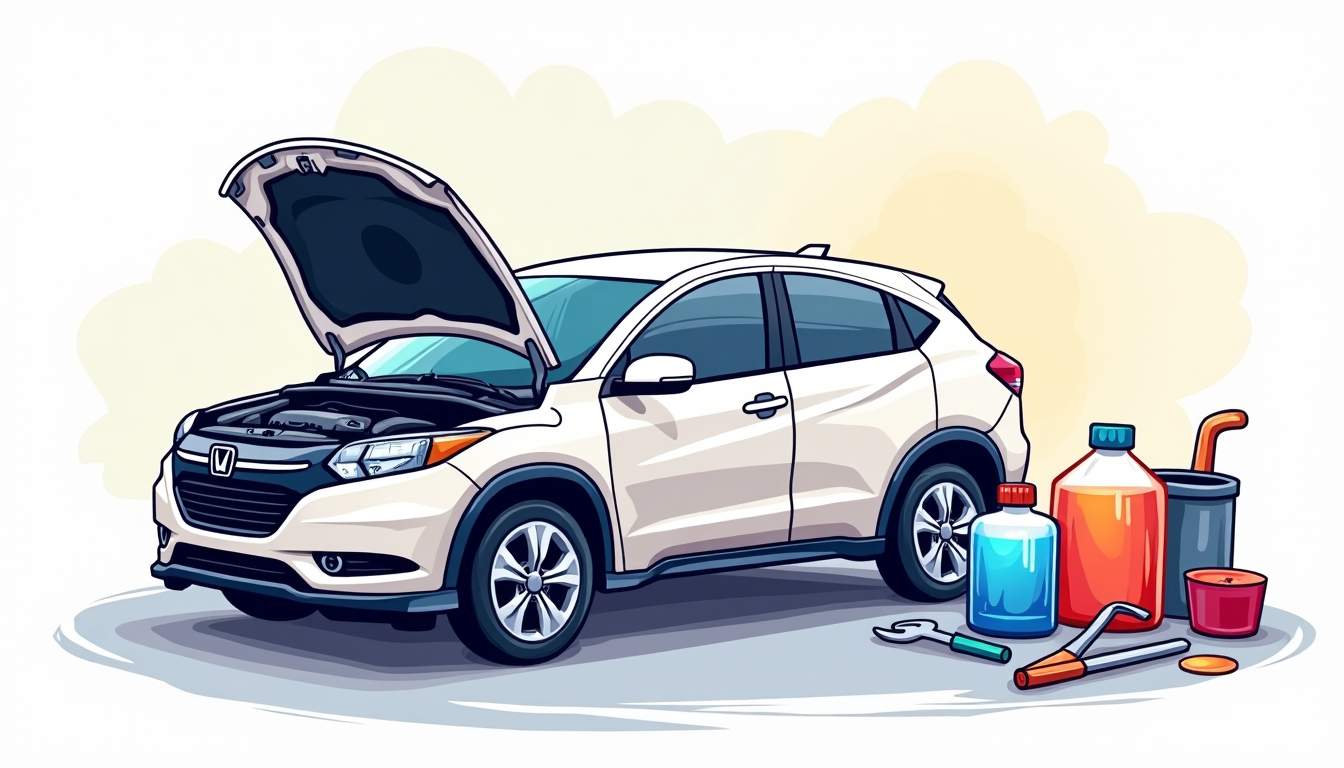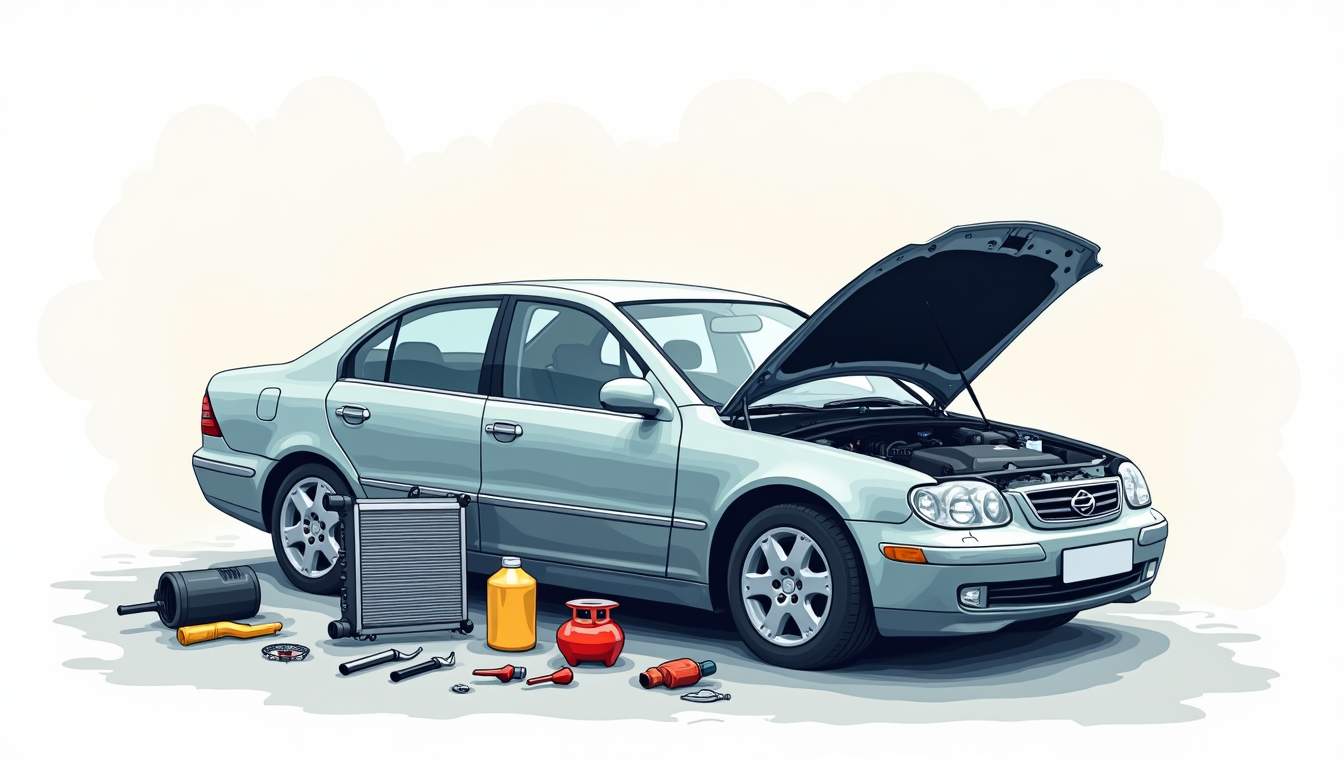
Imagine driving down the highway on a hot summer day when suddenly your temperature gauge spikes. Steam starts to billow from under the hood. Your car’s radiator has just failed. It’s a situation no driver wants to face, but understanding radiator replacement and coolant flush services can save you time, money, and stress.
Why the Radiator Matters
The radiator is the unsung hero of your vehicle’s cooling system. Its job is simple but critical: to keep your engine from overheating. The engine generates a lot of heat, and without a functioning radiator, that heat builds up quickly, leading to engine damage or even complete failure.
Inside the radiator, coolant circulates through thin tubes. Heat from the engine transfers to the coolant, which then passes through the radiator’s fins where the heat dissipates into the air. This cycle keeps the engine running at a safe temperature. The efficiency of this process is vital, especially during long drives or in hot weather, where the engine is under constant stress. A well-maintained radiator ensures that the coolant can effectively absorb and release heat, preventing the engine from reaching dangerous temperatures.
When the radiator starts to fail—whether due to corrosion, leaks, or blockages—the cooling process is compromised. This can cause your engine to overheat, which is a costly problem to fix. Additionally, the radiator itself can be a source of other issues; for instance, a leak can lead to a loss of coolant, which not only affects the radiator but can also impact other components of the cooling system, such as the water pump and thermostat. Regular inspections can help identify these problems early, allowing for timely repairs that can save you from more extensive damage down the road.
Moreover, the type of coolant used in the radiator can also play a significant role in its overall performance. Different coolants have varying properties, such as boiling and freezing points, which can affect how well they protect the engine under extreme conditions. Using the manufacturer-recommended coolant type is crucial for maintaining optimal radiator function. Additionally, flushing the radiator periodically removes contaminants and prevents sludge buildup, ensuring that the coolant can flow freely and maintain its heat-transfer capabilities. This proactive maintenance not only extends the life of the radiator but also enhances the overall efficiency of the vehicle’s cooling system. For professional assistance and services, you can visit Torrance Motors.
Signs You Need Radiator Replacement
Visible Leaks or Puddles Under Your Car
If you notice bright green, orange, or pink fluid pooling under your vehicle, it’s a strong indicator that your radiator is leaking. Coolant leaks not only reduce the efficiency of the cooling system but can also cause engine overheating. Ignoring these leaks can lead to more severe engine damage, as the engine relies on a consistent flow of coolant to maintain optimal operating temperatures. Regularly checking the ground where you park can help you catch these leaks early, potentially saving you from costly repairs down the line.
Engine Overheating
One of the most obvious signs is the temperature gauge rising above the normal range or the appearance of steam from under the hood. Overheating can happen suddenly or gradually, but either way, it’s a warning sign that your radiator may be failing. If your engine overheats frequently, it can lead to warped cylinder heads or blown gaskets, which are expensive repairs. It’s crucial to address overheating issues promptly, as they can compromise not just the radiator but the entire engine’s integrity.
Discolored or Sludgy Coolant
Coolant should be bright and clear. If it looks rusty, sludgy, or has debris floating in it, the radiator might be corroding internally. This buildup restricts coolant flow and reduces the radiator’s ability to cool the engine effectively. Additionally, discolored coolant can indicate that the coolant hasn’t been changed in a while or that there is a chemical reaction happening within the cooling system. Regular maintenance, including flushing the coolant system, can help prevent these issues and prolong the life of your radiator.
Damaged or Clogged Radiator Fins
Physical damage to the radiator fins from road debris or corrosion can reduce airflow, which is essential for cooling the fluid inside. Blocked fins mean less heat is dissipated, leading to higher engine temperatures. Furthermore, if the fins are bent or crushed, they may not be able to perform their function efficiently. Inspecting the radiator for physical damage, especially after driving on rough roads, can help identify issues before they escalate. Keeping the radiator clean and free from obstructions, such as dirt and leaves, is also essential for maintaining optimal performance.
What Happens During Radiator Replacement?
Replacing a radiator is more than just swapping out a part. It involves careful removal of the old radiator, inspection of the entire cooling system, and installation of a new, compatible radiator.

Step 1: Draining the Old Coolant
The first step is to drain the existing coolant safely. This requires proper disposal since coolant is toxic and harmful to the environment. Professionals use specialized equipment to catch and recycle or dispose of the fluid responsibly.
Step 2: Removing the Old Radiator
Next, the mechanic disconnects hoses, electrical connectors, and mounting brackets. This step requires attention to detail to avoid damaging surrounding components like the fan, thermostat housing, or transmission cooler lines if applicable.
Step 3: Inspecting Related Components
While the radiator is out, it’s a good opportunity to check hoses, clamps, and the water pump. Any worn or damaged parts should be replaced to ensure the new radiator functions properly and lasts longer.
Step 4: Installing the New Radiator
The new radiator is carefully positioned and secured. All connections are tightened to manufacturer specifications to prevent leaks. Some vehicles require refilling the transmission cooler fluid if the radiator has an integrated transmission cooler.
Step 5: Refilling with Fresh Coolant
After installation, the cooling system is refilled with the correct type and mixture of coolant. This is crucial because the wrong coolant can cause corrosion or reduce cooling efficiency.
Step 6: Bleeding the Cooling System
Air trapped inside the cooling system can cause overheating and damage. Bleeding removes air pockets, ensuring coolant circulates properly. This step often involves running the engine and using special tools or valves to release trapped air.
Understanding Coolant Flush Services
A coolant flush is a maintenance service that removes old coolant and contaminants from the cooling system and replaces it with fresh coolant. Over time, coolant breaks down and accumulates rust, scale, and debris that can clog the radiator and reduce its efficiency.

Regular coolant flushes help maintain the cooling system’s health, prevent corrosion, and extend the life of the radiator and engine components.
When Should You Get a Coolant Flush?
Most manufacturers recommend a coolant flush every 30,000 to 60,000 miles, but this can vary based on your vehicle and driving conditions. If you notice discolored coolant, overheating, or a sweet smell from the engine bay, it might be time for a flush.
What Does a Coolant Flush Involve?
The process starts by draining the old coolant. Then, a flushing agent or clean water is circulated through the system to remove rust, scale, and debris. After flushing, the system is drained again and refilled with fresh coolant in the correct ratio.
This service helps prevent clogs, corrosion, and overheating, keeping your radiator and engine running smoothly.
Benefits of Professional Radiator Replacement and Coolant Flush Services
Expertise and Proper Tools
Radiator replacement and coolant flushes require specific knowledge and equipment. Professionals ensure the job is done right the first time, preventing future problems and costly repairs.
Environmental Safety
Proper disposal of old coolant is essential to protect the environment. Professionals handle this safely, so you don’t have to worry about toxic spills or contamination.
Extended Vehicle Lifespan
Regular maintenance of your cooling system, including timely radiator replacement and coolant flushes, can extend your vehicle’s lifespan by preventing overheating and engine damage.
Peace of Mind
Knowing your cooling system is in top shape means fewer breakdowns and unexpected repairs. It’s a small investment for reliable performance and safety on the road.
DIY vs. Professional Service: What’s the Best Choice?
Some car owners consider replacing a radiator or performing a coolant flush themselves. While it’s possible for those with mechanical experience, there are risks involved.
Improper installation can lead to leaks, overheating, or damage to other engine components. Incorrect coolant mixtures or failure to bleed the system properly can cause air pockets and poor cooling performance.
Unless you have the right tools and knowledge, professional service is the safer and more reliable option.
Tips for Maintaining Your Radiator and Cooling System
- Check Coolant Levels Regularly: Low coolant can cause overheating. Top off as needed with the correct type.
- Inspect for Leaks: Look for puddles or wet spots under your car and around the radiator.
- Keep the Radiator Clean: Remove debris from the radiator fins to ensure proper airflow.
- Replace Hoses and Clamps: Worn hoses can leak or burst, leading to overheating.
- Schedule Regular Coolant Flushes: Follow manufacturer recommendations to keep the system clean and efficient.
Final Thoughts
Your vehicle’s radiator and cooling system are vital to its performance and longevity. Ignoring signs of trouble or skipping maintenance can lead to expensive repairs or even engine failure. Whether it’s time for a radiator replacement or a routine coolant flush, addressing these issues promptly keeps your car running cool and reliable.

Pay attention to the warning signs, maintain your cooling system regularly, and trust professionals to handle complex repairs. It’s an investment that pays off every time you turn the key and hit the road.

